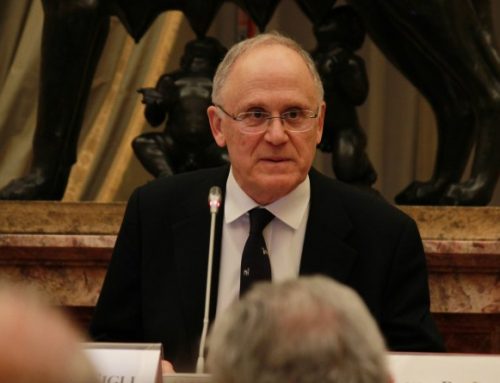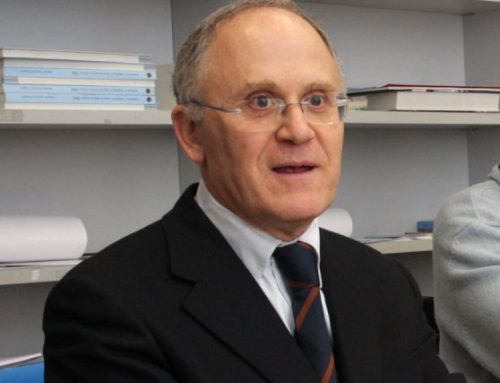This article appeared in the May 2005 edition of the Catholic Medical Quarterly
Gian Luigi Gigli
From Life to Life
John Paul II Called Home by the Heavenly Father
Dear Friends and Colleagues,
Pope John Paul II Magnus (The Great) has ended his earthly journey and has been called back home by our Heavenly Father.
Since October 16th 1978, in the middle of the winds of stormy changes, John Paul II has been the helmsman who leads, with steadfast hand, Peter’s boat toward the open sea: Duc in altum!
For more than 26 years, he led the Church in the midst of events which not only marked the history of the world, but were responsible for deep transformations in science and medical practice. During this time, the word of the Pope enlightened the minds and the hearts of health professionals and the people of God on issues concerning health, life, health care assistance, biomedical sciences and bioethics; and affirmed doctors and the other health care workers.
During these 26 years the word of the Pope has been a constant point of reference tor medical doctors and the whole world of health.
We appreciated the abundance of his Magisterium on issues related to our profession, starting from “Salvifici Doloris“, the first pontifical document on the theological value of suffering, and including the great Encyclical “Evangelium Vitae“, a true Magna Carta for all those who put their profession at the service of human life.
We will never forget that the first of these two documents was released to satisfy the request presented by FIAMC at the end of its XVth World Congress in Rome, in October 1982.
We admired his love for the sick and disabled during many visits to hospitals in Rome and other parts of the world, starting with the first day after his election, when he left the Vatican to visit a friend, Mgr. Deskur, in a Roman hospital.
We rejoiced in receiving the motu proprio “Dolentium Hominum” with which, for the first time in the history of the Church, an organic and co-ordinated work was started on a world wide scale, and the motu proprio “Vitae Mysterium“, with which the Pontifical Academy of Life was established.
We were filled with joy at seeing him raise to the honour of the altars such significant doctors of the present day as Giuseppe Moscati, Riccardo Pampuri, Gianna Beretta Molla, Pere Tarrés.
In the course of the last few years, we participated, in the dioceses and on a world scale, in the celebration of the Day of the Sick, giving life to a positive intuition of his, to bring to the attention of the authorities, public opinion, and the Church, the suffering of man, Christus patiens.
He granted special audiences to FIAMC four times: during the XVth World Congress of the Great Jubilee in 2000, two days after receiving the prayer he had composed for us; on the occasion of the 1st International Workshop of Catholic Obstetricians and Gynaecologists in 2001; and at the end of the Congress on the Vegetative State in 2004.
We received from the Pope, in the course of the Great Jubilee of the year 2500, the Prayer of the Doctor, for which we had asked and which was specifically composed for us, daily source of inspiration and comfort in the hardships and dilemmas of our profession.
Above all, the Holy Father has been for us a Teacher from the rostrum of suffering, since the days when someone attempted to take his life in 1981, when, together with so many people from all over the world, we prayed that Divine Mercy and Mary’s intercession would save his life for the good of the Church: thanks to God, our prayers were answered.
These few words are sufficient to point out the great and lasting attention the Pope has paid in his years of Pontificate to the issues of medicine.
However, it is only by going back and reading his speeches and writings that it is possible fully to grasp the love and esteem with which he has surrounded our profession.
Love and esteem prompted him to visit the home, after his death, of Prof. Crucitti, the surgeon who had operated on him after the shooting, and of kneeling on the tomb of his friend, Prof. Jerome Lejeune in Paris; love and esteem due to his awareness that the problems of birth, suffering and death are at the centre of a man’s religious experience. The way in which they are faced is the measure to evaluate the level of civilization of human societies. It is also the esteem and love which came from a man who was personally deeply marked by the experience of suffering and able, therefore, to appreciate fully the value of the medical art and the importance of health care and of scientific and biomedical research.
It was his love for those who suffer and for their doctors that we celebrated in the CD released on the occasion of the 25th anniversary of his election.
Not only did John Paul II mark the history of the XXth century. More importantly he marked the hearts and the spirits of many people. You will forgive me if, at this moment of profound emotion, I recall some personal memories.
I was in the middle of the crowd on October 16th 1978, when the joyful news, Habemus Papam, was announced to the huge assembly gathered in St. Peter’s Square in the beautiful and warm evening typical of the Roman autumn. After the very first words with which, unexpectedly, he decided to address the crowd, I felt clearly that a new wind was inflating the sails of the Church’s boat. Every fear of the future, every feeling of inferiority in face of modem times and cultures, had vanished all of a sudden. For those who had not yet understood, it became clear a few days later, during his first pontifical Mass, when he said aloud: “Don’t be afraid!”
I was taking part in a debate on television in the afternoon of May 13th 1981. There was at that time a campaign for a referendum on the abortion law in Italy. The broadcasting of the debate was interrupted abruptly to announce the news of the shooting in St. Peter’s Square. A few days later, I had the opportunity to make one of the deepest spiritual experiences of my life. In his room at the Gemelli Hospital, I had the privilege to assist at the Mass he concelebrated with his personal secretary, dressed only with the liturgical stole above his hospital clothes. No word was said, but his face transmitted an unforgettable spiritual message of abandonment to the will of God and to the love of Mary. Before he left the hospital I met him once again. I will never forget the eyes with which he looked at me, captured by a photographer.
During the following years, I attended his services many times in St. Peter’s. On one occasion I attended his private morning Mass. Thanks to my service to the Italian Association of Catholic Doctors, there were many opportunities to meet him, personally; and I had the honour of reading and presenting the offerings during his Masses. But it was only after becoming the President of FIAMC that I had the privilege of presenting him with the FIAMC address on three occasions.
He has personally blessed my wife and five children. As a specialist in Neurology, I was enlightened day by day by the strength, dignity and serenity with which he faced the illness that has been his companion during these last years. He granted me an undeserved honour when he appointed me an ordinary member of the Pontifical Academy for Life. His Pontificate coincided exactly with the entire second half of my life and marked profoundly my spiritual, familial and professional life.
Thank you Holy Father for all your gifts. You have been for us a true father and a great teacher. The Catholic Doctors are sure you are already contemplating the face of Christ in the Heavenly Jerusalem. We pray that the Church will soon recognise you among the Saints. We pray that you continue to intercede for us and for our patients.
“In Paradisum deducant te Angeli. In tuo adventu suscipiant te Martyres et perducant te in Civitatem Sanctam Jerusalem.”



